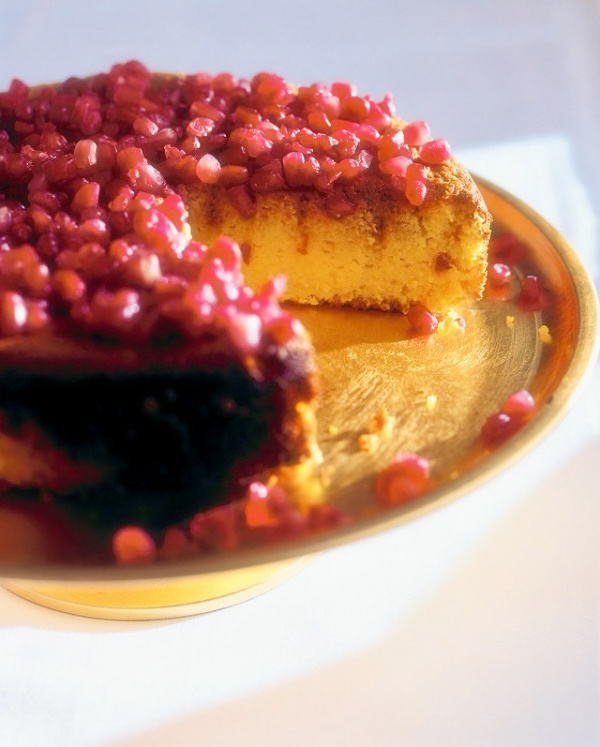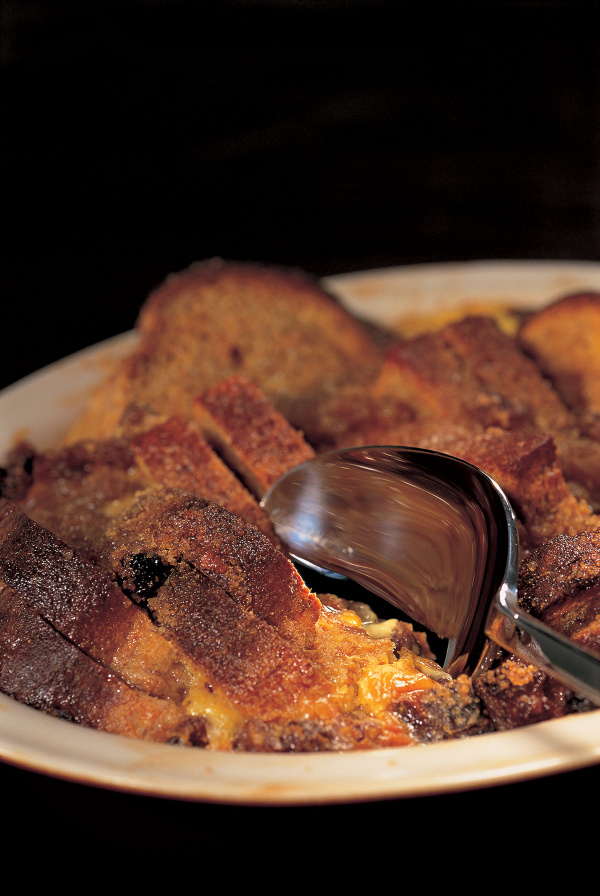Om Ali
by Nigella. Featured in HOW TO BE A DOMESTIC GODDESSIntroduction
I first ate this at Ali Baba, an Egyptian restaurant in London that the great Claudia Roden took me to about 30 years ago, and have loved it ever since; it found its way into my second book, and I've fiddled only a bit with the recipe before bringing it to the website. The quickest way to describe it to you is as a kind of Egyptian bread-and-butter-pudding: the idea is the same, though it is eggless, and pastry takes the place of the bread. That’s to say, sheets of filo are brushed with butter and cooked till crisp in a hot oven, then layered with nuts and dried fruit in a pie dish (or similar) into which you pour cream-enriched sweetened milk before baking it.
And you don’t have to feel nervous about having to keep the filo from drying out; indeed as with the Greek Patsavouropita, or Old Rag Pie, I presume Om Ali was a recipe that came into being precisely to use up leftover bits of filo, in the same way that bread-and-butter-pudding is a vehicle for using up bits of stale bread. But unless you can buy proper fresh filo pastry, then I advise you to use frozen filo which you’ve thawed, as I’ve found that fresh mass-produced filo is too floury and damp.
Om Ali is easy to make (you could indeed crisp up the filo a little in advance if that helps) quick to cook, looks beautiful — the white, the gold, and the flecks of green under its ruffled bronzed top — and tastes wonderful, offering gentle comfort, elegantly.
I first ate this at Ali Baba, an Egyptian restaurant in London that the great Claudia Roden took me to about 30 years ago, and have loved it ever since; it found its way into my second book, and I've fiddled only a bit with the recipe before bringing it to the website. The quickest way to describe it to you is as a kind of Egyptian bread-and-butter-pudding: the idea is the same, though it is eggless, and pastry takes the place of the bread. That’s to say, sheets of filo are brushed with butter and cooked till crisp in a hot oven, then layered with nuts and dried fruit in a pie dish (or similar) into which you pour cream-enriched sweetened milk before baking it.
And you don’t have to feel nervous about having to keep the filo from drying out; indeed as with the Greek Patsavouropita, or Old Rag Pie, I presume Om Ali was a recipe that came into being precisely to use up leftover bits of filo, in the same way that bread-and-butter-pudding is a vehicle for using up bits of stale bread. But unless you can buy proper fresh filo pastry, then I advise you to use frozen filo which you’ve thawed, as I’ve found that fresh mass-produced filo is too floury and damp.
Om Ali is easy to make (you could indeed crisp up the filo a little in advance if that helps) quick to cook, looks beautiful — the white, the gold, and the flecks of green under its ruffled bronzed top — and tastes wonderful, offering gentle comfort, elegantly.

Share or save this
Ingredients
Serves: 6-8
- 100 grams filo pastry (thawed if frozen)
- 50 grams butter (melted)
- 30 grams sultanas
- 50 grams whole dried apricots
- 40 grams flaked almonds
- 25 grams roughly chopped pistachios
- 25 grams pinenuts
- 500 millilitres full fat milk
- 150 millilitres double cream
- 50 grams caster sugar
- fresh nutmeg
- 4 ounces filo pastry (thawed if frozen)
- 3 tablespoons butter (melted)
- ¼ cup golden raisins
- ½ cup whole dried apricots
- ⅓ cup sliced almonds
- 2 tablespoons roughly chopped pistachios
- 2 tablespoons pinenuts
- 2 cups whole milk
- ¾ cup heavy cream
- ¼ cup superfine sugar
- fresh nutmeg
Method
- First of all, if you haven’t done it already, thaw your filo. Once it’s thawed, and your butter melted, heat the oven to 220ºC/200ºC Fan/ 425ºF and get out the biggest and shallowest oven tray you have. I use one that is 40cm x 31cm / 16 x 12 inches with a lip of a mere 2cm/ ¾ inch. But you could easily use two oven trays, or cook the filo in a couple of batches. However you’re going about it, open up your first filo sheet and transfer it to the baking tray — I find it easier to tear it into a couple or so pieces — and, using a pastry brush, paint one side with the melted butter, before turning it over and leaving it slightly scrunched, like a wet rag, on the tin. Carry on in this way with the rest of the filo sheets. Using most of the melted butter you have left, saving enough to grease a dish in a moment, brush the tops of the filo rags, and put the tray in the oven for 5-6 minutes until the filo is crisp and golden (although inside some of the folds, it will of course be pale). Leave on the tray just until you can handle it without burning yourself!
- Get out a 23-25cm/9-10 inch round pie dish or something along those lines with a 1.5l/ 6-cup capacity, and brush the rest of the butter lightly over the base and up the sides.
- Mix together all the nuts and dried fruits, and pour the milk and cream into a saucepan, stir in the sugar, and set this all aside for the merest moment.
- Now you’re ready for the layering up. Roughly break up one third of the filo sheets as you drop them into the buttered pie dish; you just want the shards to cover the bottom, give or take. Sprinkle over half of the nuts and dried fruits then top with another layer of broken-up filo, followed by the rest of the nuts and fruit, and the final layer of filo. Sit the dish on a baking sheet, just in case of spillage, though I don’t recommend using the buttery pastry tray.
- Heat the pan of milk, cream and sugar, stirring occasionally to make sure the sugar’s dissolved, until about to boil, but not actually boiling. Pour this over the layered pie dish. Grate over some nutmeg and transfer straight to the oven. Bake for 10-15 minutes, by which time the liquid will have bubbled up a bit, and thickened, and be just beginning to come away at the edges, and the top lightly browned, and billowed up with the heat. If you dig in a regular knife, you should not see much in the way of runny milk at the very top.
- Leave to stand for 10 minutes before serving.
- First of all, if you haven’t done it already, thaw your filo. Once it’s thawed, and your butter melted, heat the oven to 220ºC/200ºC Fan/ 425ºF and get out the biggest and shallowest oven tray you have. I use one that is 40cm x 31cm / 16 x 12 inches with a lip of a mere 2cm/ ¾ inch. But you could easily use two oven trays, or cook the filo in a couple of batches. However you’re going about it, open up your first filo sheet and transfer it to the baking tray — I find it easier to tear it into a couple or so pieces — and, using a pastry brush, paint one side with the melted butter, before turning it over and leaving it slightly scrunched, like a wet rag, on the tin. Carry on in this way with the rest of the filo sheets. Using most of the melted butter you have left, saving enough to grease a dish in a moment, brush the tops of the filo rags, and put the tray in the oven for 5-6 minutes until the filo is crisp and golden (although inside some of the folds, it will of course be pale). Leave on the tray just until you can handle it without burning yourself!
- Get out a 23-25cm/9-10 inch round pie dish or something along those lines with a 1.5l/ 6-cup capacity, and brush the rest of the butter lightly over the base and up the sides.
- Mix together all the nuts and dried fruits, and pour the milk and cream into a saucepan, stir in the sugar, and set this all aside for the merest moment.
- Now you’re ready for the layering up. Roughly break up one third of the filo sheets as you drop them into the buttered pie dish; you just want the shards to cover the bottom, give or take. Sprinkle over half of the nuts and dried fruits then top with another layer of broken-up filo, followed by the rest of the nuts and fruit, and the final layer of filo. Sit the dish on a baking sheet, just in case of spillage, though I don’t recommend using the buttery pastry tray.
- Heat the pan of milk, cream and sugar, stirring occasionally to make sure the sugar’s dissolved, until about to boil, but not actually boiling. Pour this over the layered pie dish. Grate over some nutmeg and transfer straight to the oven. Bake for 10-15 minutes, by which time the liquid will have bubbled up a bit, and thickened, and be just beginning to come away at the edges, and the top lightly browned, and billowed up with the heat. If you dig in a regular knife, you should not see much in the way of runny milk at the very top.
- Leave to stand for 10 minutes before serving.
Additional Information
MAKE AHEAD / STORE:
The filo can be baked 1-2 days in advance. When it is completely cold store in an airtight container in a cool, dry place. Note that the pastry will soften more quickly in a humid environment.
The Om Ali leftovers can be stored in the fridge, covered, for up to 3 days. Reheat in slices in a 200°C/180°C Fan/400°F oven for 10 minutes or eat cold.
MAKE AHEAD / STORE:
The filo can be baked 1-2 days in advance. When it is completely cold store in an airtight container in a cool, dry place. Note that the pastry will soften more quickly in a humid environment.
The Om Ali leftovers can be stored in the fridge, covered, for up to 3 days. Reheat in slices in a 200°C/180°C Fan/400°F oven for 10 minutes or eat cold.






Tell us what you think
Thank you {% member.data['first-name'] %}.
Explore more recipesYour comment has been submitted.